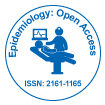Epidemiology and Clinical Presentation Respiratory Infections
Received: 26-Apr-2022 / Manuscript No. ECR-22-65679 / Editor assigned: 30-Apr-2022 / PreQC No. ECR-22-65679 / Reviewed: 13-May-2022 / QC No. ECR-22-65679 / Revised: 17-May-2022 / Manuscript No. ECR-22-65679 / Published Date: 24-May-2022 DOI: 10.4172/2161-1165.1000440
Short Communication
Introduction
Since the pneumonic plague, emerging respiratory illnesses have piqued the publics and scientific/medical communities' interest and worry, as seen by popular films depicting airborne viral outbreaks and debate over the Ebola virus's potential for respiratory dissemination. Zoonotic hosts and changes in human behaviour, such as increased worldwide travel and/or changing of our physical environment, are common themes in developing infections. While various emerging agents may be respiratory in nature, we will concentrate on emerging infections that primarily affect the respiratory system and on four representative agents that reflect a variety of emerging disease characteristics: SARS, MERS, the 2009 influenza pandemic, and Legionella spp. International tourists who have been infected can spread the virus from person to person. Civets or other mammals present in China's live-animal marketplaces may have introduced the virus into the human population, according to genetic analysis. During the outbreak, 8096 cases from 29 countries were documented, with 774 deaths. By 2004, the outbreak had been contained thanks to a massive multinational response that cost an estimated $40 billion, with no new cases reported since then.
Description
A colony of horse-shoe bats in southwestern China was discovered in November 2017 carrying a genetically similar coronavirus, raising the probability that the virus began in bats before moving to the aforementioned animal markets. SARS-CoV is communicated between humans via respiratory droplets and intimate personal contact, with certain people acting as "super spreaders." Patients that have been infected Symptoms usually appear 2–12 days after infection. During the pandemic, epidemiological research revealed that the elderly and those with immunosuppression died in disproportionate numbers. The severity of the sickness was restricted to individuals aged 12 and under [1].
The most prevalent symptoms are fever, myalgia, and malaise, which are all non-specific. Lympopenia, thrombocytopenia, high C-reactive protein, and raised lactate dehydrogenase are examples of laboratory abnormalities (LDH). Prognostic. With the establishment of hyaline membranes, there is a slight rise in alveolar macrophages. Pneumocytes exhibiting viral cytopathic-like alterations such as cytomegaly, nuclear enlargement, and conspicuous nucleoli were seen on rare occasions. Localizing viral elements inside tissue samples has been done using in situ hybridization and immunohistochemistry staining, which could be valuable for diagnosing and studying viral tropism. SARS-CoV has been found in the lungs, intestinal enterocytes, and splenic white pulp in studies [2].
8 Immunofluorescent in situ hybridization investigations in the lungs have found that viral RNA coexists with cellular cytokeratins, implying that the infected cells are pneumocytes. SARS-CoV has been found in pulmonary macrophages on rare occasions. Pneumocytes contain SARS-CoV virions and nucleocapsid inclusions, according to ultrastructural studies. Because of the non-specific character of SARSCoV infection and its fast dissemination, quick and precise diagnostics were essential for disease control. Following the initial SARS outbreak,RT-PCR tests to detect virus RNA were quickly developed [3].
The sample collection site and time after infection have an impact on the sensitivity of molecular detection. In typically, the first bodily fluid in which viral RNA is found is blood. Over 70% of patients will test positive three days following the onset of symptoms, with peak results at days 5–6.13. During the first four days, viral RNA is found in only 30–40% of respiratory tract samples, and it peaks at day 10. Serial testing should be explored if nasopharyngeal swabs are utilised for diagnostic purposes, as a minority of cases require it. At the moment of presentation, infected patients are positive. 14. In serologically confirmed SARS patients, viral RNA has been found in up to 90% of faeces samples 15–17 days after symptom start.14 As a result, where there is a high pre-test likelihood, a multimodal strategy sampling different body fluids at multiple time points early in infection may be helpful for illness detection. The location of the virus addressed may alter the clinical sensitivity of RT-PCR tests [4].
References
- Williams NC, Killer SC, Svendsen IS, Jones AW (2019) Immune nutrition and exercise: Narrative review and practical recommendations. Eur J Sport Sci 19(1):49-61.
- Gleeson M, Pyne DB, Elkington LJ, Hall ST et al (2017) Developing a multi-component immune model for evaluating the risk of respiratory illness in athletes. Exerc Immunol Rev 23:52-64.
- Kuchar E, Miskiewicz K, Nitsch-Osuch A, Kurpas D, et al (2013) Immunopathology of exercise-induced bronchoconstriction in athletes--a new modified inflammatory hypothesis. Respir Physiol Neurobiol 187(1):82-87.
- Kurowski M, Jurczyk J, Jarzębska M, Moskwa S, et al (2014) Association of serum Clara cell protein CC16 with respiratory infections and immune response to respiratory pathogens in elite athletes. Respir Res 15(1):45.
- Leicht CA, Bishop NC, Paulson TA, Griggs KE, et al (2012) Salivary immunoglobulin A and upper respiratory symptoms during 5 months of training in elite tetraplegic athletes. Int J Sports Physiol Perform 7(3):210-217.
Indexed at, Google Scholar , Crossref
Indexed at, Google Scholar , Crossref
Indexed at, Google Scholar , Crossref
Citation: Victor F (2022) Epidemiology and Clinical Presentation Respiratory Infections. Epidemiol Sci, 12: 440. DOI: 10.4172/2161-1165.1000440
Copyright: © 2022 Victor F. This is an open-access article distributed under the terms of the Creative Commons Attribution License, which permits unrestricted use, distribution, and reproduction in any medium, provided the original author and source are credited.
Share This Article
Recommended Journals
Open Access Journals
Article Tools
Article Usage
- Total views: 1755
- [From(publication date): 0-2022 - Mar 31, 2025]
- Breakdown by view type
- HTML page views: 1333
- PDF downloads: 422
